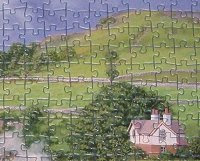Since 27th July Donna and I have been travelling around the UK with friends from Florida. This has been a time of blessing and fun for me personally, a time I'll always remember.

We have packed so much rich experience into just a few short days of living. And it seems to me that this is the way the whole of life should be lived. Life is short, so everything we experience in it should be treasured as a special privilege.
The holiday is not yet over, but it's getting closer to the end. Thinking about that brings some sadness, but reflecting on what we've done together brings great joy. Perhaps all of life is like this holiday. It has a beginning and a not-yet-experienced ending. It is a journey. It's a far richer journey when we dwell on the good things and allow the less good to flow quietly into the past and learn patience, wisdom, and trust in the process. The quality of our lives, like the quality of a holiday, is based partly on what we choose to hold onto and what we choose to let slip away without bitterness, anger or regret.
Here's a list of the outstanding things we've included so far, the things to remember and dwell on later.
- Travelling home from Gatwick Airport with two friends, and catching up with our news
- Taking the park-and-ride bus
- Visiting Oxford and eating ice-cream in 'The Eagle and Child', a popular haunt of CS Lewis
- Preparing and eating meals together, another time for informal chat
- Driving through the British countryside
- Visiting the old cathedral town of Lincoln
- Looking at a Norman house - yes, Norman!!
- Spending an evening with my eldest daughter, Debbie, and her family
- Travelling through the Pennines
- Visiting Hadrian's Wall and looking around Vindolanda
- Travelling to Edinburgh via Carlisle and Glasgow (don't ask!)
- Living on the Royal Mile as the Edinburgh Fringe gets under way
- Doing the open-top tourist bus thing
- Viewing the paintings in Edinburgh's National Gallery
- Taking friends who've never seen Edinburgh Castle to see Edinburgh Castle
- The Scottish Crown Jewels
- Driving the east coast road and stopping at the English border
- Durham and it's wonderful cathedral
- Spending another evening in York, with my younger daughter and her family
- Visiting York Minster and the undercroft
- Arriving home again
- Meeting with others at home, sharing a meal, prayer together, bread and wine, a great chance for people to chat, a time of blessing and encouragement
- Another trip to Oxford, a pub lunch, the CS Lewis walking tour
- Taking our friends to the station to visit London on their own
- Collecting them again at Kew Green tube station
- Visiting Kew Gardens
- Visiting 'Talkin' Headz', a drum shop in Woburn Sands
- Sitting on the patio chatting
- Taking our guests back to Gatwick to fly home

So many happy memories, and still a few more to come. Life is rich, and good, and full. Life is like a meadow in the summer, filled with every kind of flower, dancing with butterflies and shimmering on a hot, dry day. As I write, the rain is pounding on the conservatory roof - but that, too, is a wonderful thing, what a sound! In the garden it's soaking into the good earth and making the plants flourish. They need the sunshine, but they need the rain too. Sunshine and water combining to generate abundant and carefree life. The rain today and perhaps the sunshine tomorrow.
We're rather like those plants, we need sunshine and rain in our lives to truly thrive.
Previous | Part 1 of a series | Next







